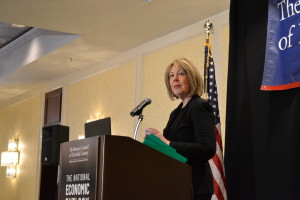Economic growth has been slow in Fairfield County and Connecticut, but momentum on the national level is sure to positively drift this way, experts say.
At an economic outlook Jan. 15 at the Stamford Marriott, Rae Rosen, vice president of the Federal Reserve Bank of New York, told members of the Business Council of Fairfield County a stronger recovery was on its way, leaving members optimistic about the new year.
“It”™s definitely a better market overall for those trying to enter the workforce and for those trying to get back into the market,” Rosen said. “The labor force was contracting because people were dropping out who”™d normally be in the workforce. But as the market becomes more robust, I think we”™ll see a pickup in the labor market itself.”

Rather than a continuation of very slow growth, momentum seems to be building in national employment, consumer spending and the real estate market. The cost of total employee compensation has stabilized and manufacturing outputs are rising, Rosen said.
Year-over-year, private sector employment in Fairfield County increased only 1.25 percent in 2013, and just under 60 percent of the private-sector jobs lost during the Great Recession have been recovered. However, the two-year national economic outlook adds up to a favorable outcome, said Chris Bruhl, CEO of the Business Council.
“The recovery isn”™t just tentative, it”™s gathering steam,” Bruhl said. “We can be confident again.”
“Anyone who”™s held off on hiring can go ahead and add jobs and those thinking about going back to school will be rewarded,” he added.
Optimism aside, however, Rosen made sure to address public concerns like the decreasing labor force and the widening gap between rich and poor.
The national unemployment rate in October was 7.3 percent, down from 10 percent in 2010, but that rate is largely dismissed by the fact more people have given up looking for work.
“We know the unemployment rate has gone down and yet it doesn”™t make us feel any better because we know there wasn”™t this huge surge in employment,” Rosen said. “People just dropped out.”
At the end of 2013, the national labor force participation rate was at 63 percent, which is likely 7 percentage points lower than what it should be, Rosen said.
The majority of people who have given up looking for work are between the ages of 25 and 54 years old and are predominately male, which is a primary source of the skilled labor pool, Rosen said.
The most job growth has been in high- or low-skilled occupations, which can explain why people somewhere in the middle have stopped looking, Rosen said. Many have moderate-skill levels and aren”™t gaining higher skill sets as they sit out of the workforce.
Going forward, the unemployment rate isn”™t going to go down fast, Rosen said. “There”™s a lot of people who want to work.”



















